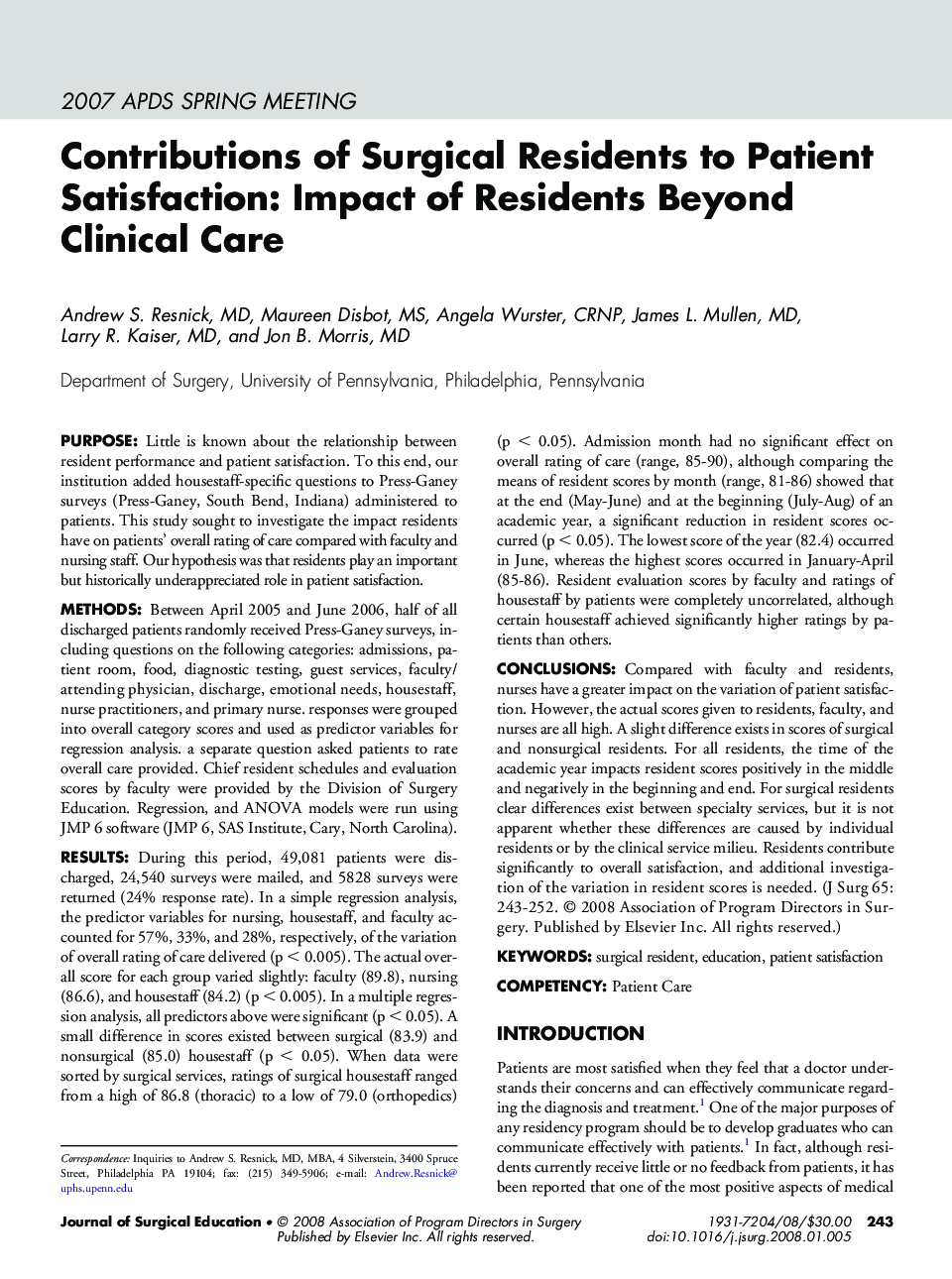| کد مقاله | کد نشریه | سال انتشار | مقاله انگلیسی | نسخه تمام متن |
|---|---|---|---|---|
| 4298939 | 1288375 | 2008 | 10 صفحه PDF | دانلود رایگان |

PurposeLittle is known about the relationship between resident performance and patient satisfaction. To this end, our institution added housestaff-specific questions to Press-Ganey surveys (Press-Ganey, South Bend, Indiana) administered to patients. This study sought to investigate the impact residents have on patients' overall rating of care compared with faculty and nursing staff. Our hypothesis was that residents play an important but historically underappreciated role in patient satisfaction.MethodsBetween April 2005 and June 2006, half of all discharged patients randomly received Press-Ganey surveys, including questions on the following categories: admissions, patient room, food, diagnostic testing, guest services, faculty/attending physician, discharge, emotional needs, housestaff, nurse practitioners, and primary nurse. responses were grouped into overall category scores and used as predictor variables for regression analysis. a separate question asked patients to rate overall care provided. Chief resident schedules and evaluation scores by faculty were provided by the Division of Surgery Education. Regression, and ANOVA models were run using JMP 6 software (JMP 6, SAS Institute, Cary, North Carolina).ResultsDuring this period, 49,081 patients were discharged, 24,540 surveys were mailed, and 5828 surveys were returned (24% response rate). In a simple regression analysis, the predictor variables for nursing, housestaff, and faculty accounted for 57%, 33%, and 28%, respectively, of the variation of overall rating of care delivered (p < 0.005). The actual overall score for each group varied slightly: faculty (89.8), nursing (86.6), and housestaff (84.2) (p < 0.005). In a multiple regression analysis, all predictors above were significant (p < 0.05). A small difference in scores existed between surgical (83.9) and nonsurgical (85.0) housestaff (p < 0.05). When data were sorted by surgical services, ratings of surgical housestaff ranged from a high of 86.8 (thoracic) to a low of 79.0 (orthopedics) (p < 0.05). Admission month had no significant effect on overall rating of care (range, 85-90), although comparing the means of resident scores by month (range, 81-86) showed that at the end (May-June) and at the beginning (July-Aug) of an academic year, a significant reduction in resident scores occurred (p < 0.05). The lowest score of the year (82.4) occurred in June, whereas the highest scores occurred in January-April (85-86). Resident evaluation scores by faculty and ratings of housestaff by patients were completely uncorrelated, although certain housestaff achieved significantly higher ratings by patients than others.ConclusionsCompared with faculty and residents, nurses have a greater impact on the variation of patient satisfaction. However, the actual scores given to residents, faculty, and nurses are all high. A slight difference exists in scores of surgical and nonsurgical residents. For all residents, the time of the academic year impacts resident scores positively in the middle and negatively in the beginning and end. For surgical residents clear differences exist between specialty services, but it is not apparent whether these differences are caused by individual residents or by the clinical service milieu. Residents contribute significantly to overall satisfaction, and additional investigation of the variation in resident scores is needed.
Journal: Journal of Surgical Education - Volume 65, Issue 3, May–June 2008, Pages 243–252